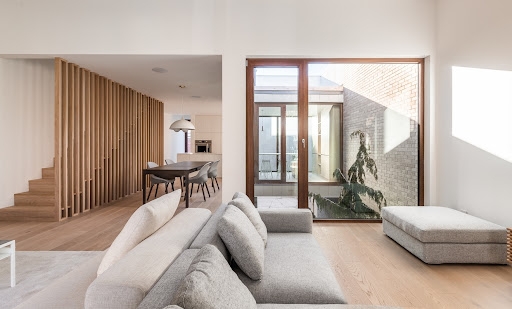Interior Design and Wood Flooring: Our Top Tips

Interior Design and Wood Flooring: Our Top Tips
Interior design and wood flooring form an essential duo. This noble material brings warmth, character and elegance to any space it inhabits. By making the most of orientation, plank width and wood colour, you have the power to radically transform the atmosphere of your rooms.
In this article, we take a deep dive into the various characteristics that make wood flooring such a versatile choice when it comes to decorating. Whether you're planning to redecorate your home or are simply looking for new ideas, this blog will offer you a wealth of tips and insights to help you make the most of wood flooring's potential in your spaces.
Wide Hardwood Planks
There are several reasons for the popularity of wide planks. First and foremost, the aesthetic appeal they bring to a room is undeniable. Wide planks give the impression of a larger, brighter space, making even the smallest spaces feel luxurious and elegant. This effect is amplified by the fact that fewer joints are visible with wider planks, creating a visually more soothing and cohesive environment.
History also plays a part in this popularity. In the 17th century, if you needed a new floor, wide hardwood planks were often your only option. While the choices are more varied today, the nostalgia and classic charm of wide planks remain.
Then there's the aspect of exclusivity. Nowadays, the production of wide hardwood planks is more complex than that of standard-size planks. As a result, their supply is limited, leading to higher demand and higher prices. This rarity can increase their appeal, as they are perceived as more luxurious and unique.
Fortunately, at Barwood Pilon, most of our floors are available in wide planks!
Finally, despite their lesser availability compared to standard-size planks, wide hardwood planks are just as popular, if not more so. Designers and homeowners alike are seduced by their unique charm, luxurious appearance and sense of spaciousness. This tried-and-tested trend continues to grow in popularity, despite its higher price and more complex production.
Flooring Direction: What's the Best Solution?
The orientation of flooring planks is a key element in the design of a space, and the best direction depends largely on the specifics of the room concerned.
Floor coverings arranged perpendicularly, also known as horizontally, draw the eye from one side of the room to the other. This can help create the illusion of a larger space, especially in wide rooms. However, it's important to note that in narrow or very compact spaces, perpendicular planks could have the opposite effect, making the room even smaller than it already is.
On the other hand, floor coverings arranged in parallel, also known as vertical, guide the eye forward, for example towards an entrance, window or other architectural feature. This is the traditional orientation for most flooring installations. It adds a dimension of depth to a space, especially small rooms. However, if the aim is to make a room cozier or minimize its apparent size, parallel planks may not be the best choice, as they tend to visually elongate the space.
The choice between perpendicular or parallel orientation should be based on the dimensions of the room, the desired effect and the architectural elements present. It's a decision that needs to be taken with care, as it has a significant impact on the perception of space.
Contrast Between Flooring and Décor
Contrast between flooring and décor is a key element in the design of a space. Flooring can be used to harmonize the space or to create contrast.
In the first case, you can choose a floor covering that matches the colour of the walls or furniture. For example, if you have light-coloured walls, choosing a light-coloured floor can help balance your space and create a coherent, harmonious look. This type of design, where colours complement and blend with each other, can give a sense of continuity and spaciousness.
On the other hand, you can also use flooring to create contrast in a room. This can be done by pairing the floor with furniture or walls of a different colour. For example, dark hardwood flooring can add a visually appealing element to a room with white walls. The contrast between dark and light colours creates an interesting dynamic and can help to highlight specific elements of the space.
The Importance of Hardwood Flooring Colour
Floor colour can have a significant impact on the overall atmosphere of a room and contribute greatly to the overall aesthetic.
From a traditional perspective, dark wood floors are often the preferred choice. These colours, such as espresso or chocolate, add a touch of sophistication to the space and offer versatility, being able to complement almost any style of furniture. What's more, dark woods can lend a sense of warmth and comfort to a room, and create a certain visual drama.
On the other hand, for a more contemporary, minimalist look, a lighter hardwood such as white oak or maple might be preferable. These types of wood tend to brighten up a room, making the space feel more open and airy, which is particularly useful in small spaces or rooms with little natural light.
Ultimately, the choice of flooring colour should reflect your personal preferences and match the atmosphere you wish to create. It's a crucial aspect of interior design that can influence the perception of space, warmth and overall comfort of a room.

